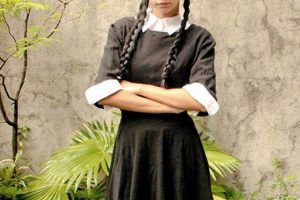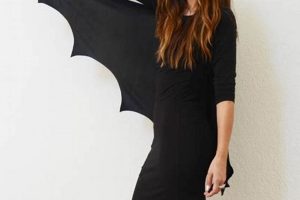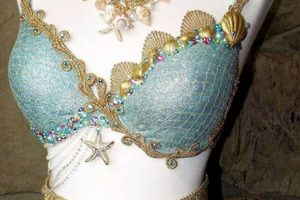A self-assembled Dalmatian-themed outfit involves the creation of attire emulating the distinctive spotted coat of the Dalmatian dog breed, typically for celebratory events such as Halloween or costume parties. This endeavor commonly requires accessible materials and basic crafting skills, allowing individuals to fashion a personalized and cost-effective facsimile of the animal’s appearance. For instance, a white garment can be adorned with black spots using fabric paint or adhesive felt to simulate the iconic pattern.
The appeal of constructing such apparel lies in its affordability, adaptability, and the opportunity for creative expression. Compared to purchasing a pre-made ensemble, a handcrafted version provides significant cost savings and enables customization in terms of fit, style, and level of detail. Historically, animal-themed costumes have been popular, reflecting a long-standing human fascination with the natural world and a desire to embody its characteristics.
The subsequent sections will delve into the necessary materials, step-by-step construction techniques, and considerations for adapting the design for various age groups and skill levels. These explorations will provide a complete guide to achieving a successful and visually appealing representation of the subject.
Construction Insights for a Dalmatian-Inspired Outfit
The following guidelines provide critical advice for achieving a visually accurate and durable homemade ensemble. Adherence to these suggestions enhances the final product’s quality and ensures longevity.
Tip 1: Select Durable Base Garments: Opt for white clothing items composed of robust materials such as cotton or fleece. These fabrics withstand the application of adhesives and paint more effectively than delicate or synthetic alternatives.
Tip 2: Employ High-Quality Adhesives and Paints: Fabric-specific adhesives or paints are crucial for preventing spot detachment or color bleeding. Test small, inconspicuous areas of the base garment before applying extensively.
Tip 3: Utilize Stencils for Uniform Spot Application: Stencils fashioned from cardboard or plastic ensure consistent spot size and shape, contributing to a more professional and polished appearance.
Tip 4: Allow Adequate Drying Time: Adhesives and paints require ample time to cure fully. Premature handling can result in smudging or incomplete bonding, compromising the visual integrity of the costume.
Tip 5: Secure Spots Strategically: When using adhesive felt spots, reinforce edges with fabric glue to prevent peeling, particularly in areas subject to frequent friction.
Tip 6: Consider the Proportions: Scale spot sizes proportionally to the wearer’s size. Smaller spots are generally more visually appealing on younger children, while larger spots can suit adult-sized attire.
Tip 7: Implement Layering Techniques: Applying multiple thin coats of paint, rather than one thick coat, promotes even coverage and reduces the likelihood of cracking or peeling over time.
Following these directives maximizes the likelihood of producing a visually appealing, resilient, and comfortable Dalmatian-themed outfit. The emphasis on quality materials, careful application, and proper drying protocols ensures lasting value and enhances the overall impact.
The concluding section will offer advice on accessorizing the ensemble and provide guidance on maintenance and storage to preserve its condition for future use.
1. Fabric Selection
Fabric selection exerts a primary influence on the overall success of a self-assembled Dalmatian-themed outfit. The chosen material directly impacts comfort, durability, and the realistic portrayal of the animal’s coat. Inappropriate fabric choices can result in an ill-fitting, easily damaged, or visually unconvincing costume. For example, a stiff, non-breathable fabric may cause discomfort during extended wear, while a loosely woven material might not adequately support the application of spots, leading to premature detachment or fading. The selection process, therefore, becomes a crucial determinant of the final product’s effectiveness.
Specific considerations within fabric selection encompass weight, texture, and colorfastness. A heavier fabric, such as fleece or felt, provides warmth and lends itself well to the attachment of appliqued spots. Smoother fabrics, like broadcloth or poplin, offer a suitable base for painted spots, allowing for greater detail and precision. Colorfastness is essential to prevent bleeding or fading during washing or exposure to sunlight, maintaining the costume’s visual integrity over time. The selection between natural and synthetic fibers presents further trade-offs, balancing breathability, cost, and maintenance requirements.
In conclusion, fabric choice is not merely a superficial element, but rather an integral component determining the functionality and aesthetic appeal of the completed Dalmatian-inspired attire. Overlooking the properties of the base material introduces challenges related to comfort, durability, and visual accuracy, potentially compromising the entire undertaking. A thoughtful evaluation of fabric characteristics significantly enhances the likelihood of a successful and satisfying outcome.
2. Spot Application
Spot application represents a fundamental technique in the creation of a self-assembled Dalmatian-themed outfit. The method used to apply the characteristic spots significantly influences the costume’s authenticity and visual appeal. Proper execution of this element is crucial for achieving a convincing representation of the Dalmatian’s distinctive coat.
- Spot Size and Proportion
The size and proportion of the applied spots directly impact the realism of the costume. Spots that are too large or too small relative to the garment’s size can distort the intended effect. A consistent spot size, adhering to the breed’s typical markings, enhances visual accuracy. For example, research into authentic Dalmatian markings suggests a range of spot sizes, which can inform stencil creation or freehand application. In the context of a child’s outfit, smaller spots may be preferred to avoid overwhelming the design.
- Application Method
Various methods exist for spot application, each with its own advantages and disadvantages. Painting, using fabric-specific paints, allows for precise control over spot shape and placement, but requires patience and a steady hand. Felt appliqus offer a textural dimension and are easily attached with adhesive, but may lack the refined edges achievable with paint. Stenciling provides a consistent and repeatable spot pattern, suitable for mass production. The choice of method hinges on the crafter’s skill level, desired aesthetic, and available resources.
- Spot Distribution and Density
The distribution
and density of spots across the garment are critical for replicating the Dalmatian’s natural markings. Random, yet balanced, placement of spots is preferable to overly uniform patterns. High-density spotting, especially on areas like the sleeves and torso, contributes to a fuller, more convincing representation. Conversely, sparse spotting can appear incomplete or unfinished. Attention to these details distinguishes a well-executed outfit from a less authentic imitation. - Material Compatibility
The compatibility of the spot application material with the base garment fabric is paramount. Fabric paints must be designed for the chosen fabric type to ensure proper adhesion and prevent bleeding or cracking. Adhesives used for felt appliqus must be strong enough to withstand washing and wear without damaging the underlying material. Careful consideration of material interactions is essential for long-lasting results. Incompatibility can lead to a compromised final product, necessitating costly repairs or a complete re-do of the application process.
In conclusion, spot application is not merely a cosmetic addition, but rather a core element in the success of any Dalmatian-themed garment. From selecting the right method and materials to careful consideration of spot size, distribution, and density, a holistic approach to this technique is critical for achieving an authentic and visually appealing representation. Neglecting these aspects risks producing a substandard result, undermining the overall impact of the self-assembled outfit.
3. Material Durability
Material durability holds substantial importance in the context of a self-assembled Dalmatian-themed outfit. The longevity and resilience of the chosen materials directly impact the lifespan and visual appeal of the final product. A lack of durable materials causes premature wear, tear, and degradation of the costume, diminishing its value and intended use. For instance, using low-quality fabric paint can result in faded or cracked spots after minimal use, while poorly adhered felt appliqus may detach, leaving an incomplete appearance. This demonstrates a clear cause-and-effect relationship where inferior material quality leads to reduced costume integrity.
The selection of appropriate materials, with an emphasis on durability, translates to practical benefits in the long term. A costume crafted from robust fabrics like fleece or canvas, combined with high-quality adhesives and paints, withstands repeated wear, washing, and storage without significant deterioration. This contributes to a more sustainable approach to costume creation, minimizing the need for frequent replacements. Consider the example of a parent investing in durable materials for a child’s costume. The initial higher cost is offset by the costume’s ability to last through multiple Halloweens or dress-up occasions, representing a more economical solution overall. Furthermore, the use of resilient materials improves the costume’s safety. Materials susceptible to tearing or fraying can create potential hazards, particularly for young children.
In summary, material durability is not merely a desirable attribute but a critical component in the design and construction of a Dalmatian-inspired ensemble. The selection of long-lasting fabrics, adhesives, and paints directly correlates with the costume’s lifespan, visual quality, and overall value. Challenges related to material selection often arise from budget constraints, but the long-term benefits of investing in durable options outweigh the initial cost savings of using inferior alternatives. A comprehensive understanding of material properties, including wear resistance, colorfastness, and structural integrity, is therefore essential for achieving a successful and sustainable outcome.
4. Pattern Accuracy
In the realm of crafting a self-assembled Dalmatian-themed outfit, meticulous attention to pattern accuracy is paramount. The degree to which the design mirrors the actual characteristics of the Dalmatian breed significantly influences the costume’s authenticity and overall visual success. A poorly executed pattern, deviating substantially from the animal’s true markings and proportions, can result in a caricature rather than a convincing representation.
- Spot Distribution Fidelity
The distribution of spots on a Dalmatian is neither uniform nor entirely random; it follows general patterns that contribute to the breed’s distinct appearance. An accurate pattern should replicate this balance, avoiding overly symmetrical arrangements or haphazard clustering. For example, the head and ears typically exhibit smaller, more concentrated spots compared to the body. Deviations from these observed patterns diminish the costume’s credibility.
- Proportional Spot Size
The size of the spots relative to the overall garment’s dimensions and the wearer’s size demands careful consideration. Spots that are excessively large can appear cartoonish, while those that are too small may become visually insignificant. Accurate patterns often incorporate varying spot sizes to mimic the natural variations found on real Dalmatians, enhancing the costume’s realism.
- Anatomical Correctness
Beyond the spots, the overall shape and construction of the costume should reflect the Dalmatian’s anatomy. This includes accurately representing the length of the torso, the shape of the head, and the placement of limbs, if the costume is designed to fully embody the animal. Failure to adhere to these anatomical principles can result in a disproportionate and unconvincing final product. Illustrations and reference images serve as essential guides in achieving anatomical accuracy.
- Color Fidelity
While Dalmatians are most commonly associated with black spots on a white background, variations do exist. Furthermore, the precise shade of black can influence the perceived authenticity of the costume. An accurate pattern accounts for these color nuances, ensuring that the selected materials closely match the breed’s typical coloration. For instance, a brownish-black may be more suitable than a jet-black in certain instances.
Collectively, these facets underscore the critical role of pattern accuracy in transforming a simple, homemade outfit into a compelling representation of a Dalmatian. Whether adapting a pre-existing pattern or creating one from scratch, rigorous attention to these details significantly enhances the costume’s visual impact and overall effectiveness in conveying the intended subject. The greater the commitment to accurate replication, the more successful the result.
5. Cost Effectiveness
The intersection of “Cost Effectiveness” and a self-assembled Dalmatian-themed outfit arises from the inherent economics of crafting versus purchasing a pre-made costume. The primary impetus for undertaking a “diy dalmatian costume” project often stems from the potential for significant savings compared to commercially available alternatives. This cost advantage is realized through the utilization of readily available materials, repurposed garments, and the elimination of retail markups.
For instance, a simple white t-shirt and leggings, adorned with hand-painted or felt-attached spots, can replicate the desired aesthetic at a fraction of the cost of a professionally manufactured costume.
The practical implications of this cost-conscious approach extend beyond mere financial savings. A “diy dalmatian costume” allows for greater control over the budget, enabling individuals to prioritize specific materials or embellishments based on their affordability. This flexibility is particularly beneficial for families operating under constrained financial circumstances or for those seeking to minimize the environmental impact associated with mass-produced, disposable costumes. Moreover, the process of creating a costume from scratch fosters resourcefulness and encourages the utilization of existing resources, further reducing the overall expenditure. Consider the example of a school requiring students to dress up; the option of a “diy dalmatian costume” makes participation economically accessible to a broader range of families.
In conclusion, “Cost Effectiveness” serves as a central motivating factor and a tangible benefit associated with crafting a Dalmatian-themed outfit. The capacity to achieve a visually appealing and thematically appropriate costume at a reduced expense represents a compelling argument for adopting a do-it-yourself approach. While challenges may arise in sourcing materials or allocating time for the project, the potential for significant financial savings and increased creative control solidifies the practical significance of understanding the cost-effectiveness considerations inherent in the “diy dalmatian costume” endeavor.
6. Customization Options
The degree of self-direction available through diy dalmatian costume construction is intrinsically linked to the concept of Customization Options. The impetus to create a self-made ensemble is frequently driven by a desire to surpass the limitations imposed by mass-produced, commercially available costumes. The ability to tailor various aspects of the design to individual preferences, body types, or specific thematic requirements constitutes a primary advantage of the “diy” approach. A “diy dalmatian costume”, therefore, represents an opportunity to express individuality and creativity in ways that are not possible with pre-fabricated alternatives. For example, individuals may choose to incorporate unique accessories, such as a personalized collar with the Dalmatian’s name or a spotted bow tie, to distinguish their creation. The impact of these customization options is a more personalized and meaningful outcome.
The practical application of this understanding manifests in a multitude of ways. A parent crafting a diy dalmatian costume for their child might choose to adapt the design to accommodate specific sensory needs by using softer fabrics or avoiding restrictive closures. Similarly, a theatrical production could leverage customization options to create a Dalmatian ensemble that aligns perfectly with the overall aesthetic vision of the show, perhaps incorporating specific colors or stylistic elements to enhance the visual narrative. Moreover, the “diy” approach facilitates adjustments for different age groups and body types, ensuring a comfortable and well-fitting costume for all participants. For example, a costume for a toddler would prioritize ease of movement and safety, while a costume for an adult might emphasize stylistic accuracy and attention to detail. Customization also extends to the level of crafting skill involved. Simpler designs using readily available materials are suitable for novice crafters, whereas more elaborate creations can challenge experienced artisans. This allows for the creation of a truly bespoke item reflecting the skills and desired outcome of its creator.
In summary, “Customization Options” are not merely ancillary features of a diy dalmatian costume, but rather core components that define its appeal and value. The ability to personalize the design, accommodate specific needs, and express individual creativity contributes significantly to the overall success and satisfaction derived from the project. While challenges may arise in terms of design complexity or material sourcing, the freedom and control afforded by customization options make the diy approach a compelling alternative to commercially available costumes. Understanding this connection enhances the potential for crafting a truly unique and memorable Dalmatian-themed ensemble.
DIY Dalmatian Costume
The following addresses prevalent inquiries regarding the creation of a self-assembled Dalmatian-themed ensemble. These responses aim to provide clear and informative guidance for individuals undertaking such a project.
Question 1: What fabrics are most suitable for a DIY Dalmatian costume?
Durable, readily available fabrics such as fleece, felt, and cotton are generally appropriate. The selection should prioritize comfort, washability, and the ability to securely accommodate the applied spots.
Question 2: How should the spots be applied to the costume?
Spot application methods include fabric painting, felt appliqus attached with adhesive, and stenciling. The optimal method depends on desired aesthetic precision, skill level, and material compatibility.
Question 3: What type of adhesive is recommended for attaching felt spots?
Fabric-specific adhesives designed for permanent bonding are essential. Test the adhesive on a small, inconspicuous area of the fabric before widespread application to ensure compatibility and prevent damage.
Question 4: How can spot distribution be made more realistic?
Employ a random, yet balanced, distribution pattern. Reference images of actual Dalmatians provide useful guidance. Avoid overly symmetrical or uniformly spaced arrangements.
Question 5: What are the cost implications of a DIY Dalmatian costume versus a purchased one?
A DIY approach typically results in significant cost savings. Repurposing existing garments and utilizing affordable materials contribute to this advantage.
Question 6: Can a DIY Dalmatian costume be adapted for different age groups?
Yes. The design can be easily modified to accommodate varying sizes and comfort requirements. Simpler construction techniques are suitable for younger children, while more intricate details can be incorporated for older individuals.
Successful completion of a “diy dalmatian costume” requires careful consideration of fabric selection, spot application techniques, and attention to realistic pattern design. Adherence to these guidelines ensures a visually appealing and durable final product.
Subsequent sections will explore advanced techniques for enhancing the visual impact and longevity of the costume, including recommendations for maintenance and storage.
DIY Dalmatian Costume
This exploration has highlighted essential aspects of creating a “diy dalmatian costume.” Key points included material selection, spot application techniques, pattern accuracy, material durability, cost-effectiveness, and customization options. Each of these facets contributes significantly to the overall success of the endeavor, impacting the visual appeal, longevity, and personal satisfaction derived from the project. A thoughtful consideration of these factors empowers individuals to achieve a compelling and individualized representation of the Dalmatian breed.
The undertaking of a “diy dalmatian costume” project represents more than a mere cost-saving
measure. It embodies a commitment to creativity, resourcefulness, and the expression of individual style. As crafting skills continue to evolve and access to materials expands, the potential for innovative and personalized costume design will undoubtedly increase, ensuring the continued relevance of the self-assembled approach. Future projects should emphasize sustainable material sourcing and environmentally conscious construction techniques to further enhance the value and impact of the effort.







